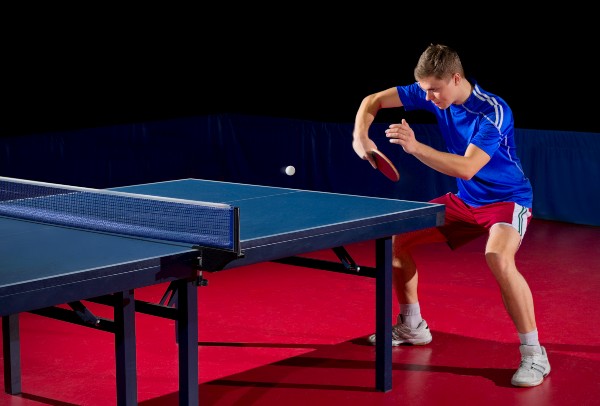If your opponent does a short backspin serve, how do you return it? Do you push the ball or try to flick it?
From my experience of local league table tennis, especially in the lower divisions, most players return a short backspin serve with a push.
This is the high percentage, safe option. You just need to angle your bat correctly and brush under the ball, and you will return the serve safely over the net.
But is this the best option? Could you gain a bigger advantage by attempting a backhand or forehand flick?
Benefits of the flick
For me, there are three main benefits of returning short backspin serves with a flick.
Firstly, the surprise factor. In local league table tennis, not that many players flick. So when your opponent does a short backspin serve, he is usually expecting you to push the ball back. When you flick instead, your opponent is caught by surprise, and will often play a passive shot, giving you the opportunity to dominate the rally. Often your flick doesn’t even have to be that good. Just by playing a shot your opponent wasn’t expecting can give you an advantage.
The second benefit is speed. A push tends to be a slower shot. This gives your opponent more time to recover after the serve and play his next shot. A flick is a faster shot. The ball comes at your opponent quicker. If you get a good topspin contact, the ball should also kick off the table, reducing the reaction time of your opponent even more. The result? Your opponent is often forced into playing a more passive shot. Sometimes you may hit outright winners, as your opponent is too slow to recover after the serve and the flick shot is too fast.
And thirdly, you take the attacking initiative. The main reason players serve short backspin is to make it hard for the other player to attack. He wants you to push. But if you flick instead, then you get the first attack on the table. You put your opponent under instant attacking pressure. This can be quite off putting for your opponent. If he serves short, you attack. If he serves long, you attack. He always feels as though he is on the back foot, always responding to your attacks.
If you are an attacking player, using flicks will be very beneficial to your playing style. You will get straight into a topspin rally, which will hopefully benefit you more than your opponent. You bypass these tedious pushing rallies. Your opponent serves short, you flick, and then topspin, topspin, topspin.
Is it OK to push?
Having highlighted the benefits of flicking, it doesn’t mean you have to flick every short backspin serve. It is OK to push sometimes.
Against some opponents, a push may be a better option. For example, if you are playing a flat hitting attacker who struggles to loop backspin, you may get plenty of success by returning short backspin serves with a push. The flat hitting attacker still may try to attack but will often hit the ball in the net.
Or if you are playing a very strong topspin attacker, you may have more success trying to return short backspin serves with a short push. If you flick too much, it may set this opponent up to counter attack – putting you on the back foot. But if you push short, the topspin attacker will have to work harder to gain the attacking initiative.
And there are many ways you can use your push to cause disruption – short pushes, long pushes, wide pushes, sidespin pushes, heavy backspin pushes. Here’s a video about how to use your pushes more effectively.
For some players, using both flicks and pushes, is a very good strategy. By mixing up how your return short backspin serves will keep your opponent guessing. The variety of your returns is likely to cause a lot of problems. So much so, he will probably stop serving short backspin!
Mastering flicks
Getting a good flick will add a new dimension to your game. I consider the backhand flick to be an essential shot, which every player should try and learn.
The backhand flick is easier to learn and execute than the forehand flick. You can use a backhand flick in different parts of the table, as long as you get your feet in the right position. You can generate lots of speed and spin and put your opponent on the defensive straight away.
Of course, the forehand flick is useful to learn too, but if you are new to flicking, I would recommend focusing on the backhand flick first. Get confident in using this shot and it will give you extra attacking options when you play. You don’t always have to flick, but it’s reassuring to know that you can flick when you want to.
Here’s two videos to help you learn how to flick…
Need technique advice?
If you need help with your game, I recommend you join Tom’s TT Academy. You can submit video footage for analysis and get help from me in my coaching clinic. You will also get access to a wide range of coaching content, including
- in-depth courses
- training drills
- fitness videos
- robot training videos
- member discussions
- skill challenges
- and lot’s more!
You can access all this content for less than £1 per week. New content is added regularly. Join hundreds of table tennis players around the world today at tomsttacademy.com

